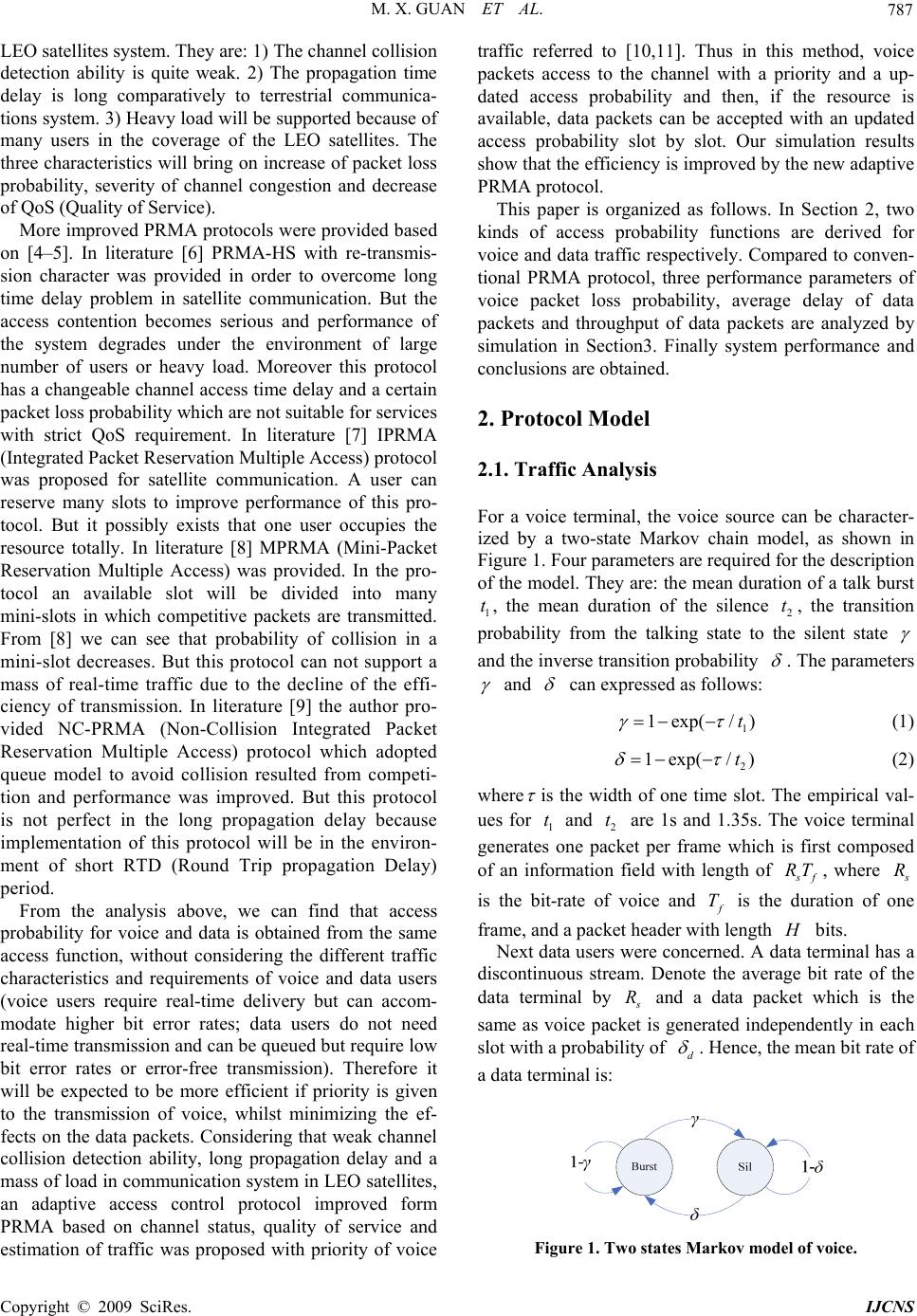
M. X. GUAN ET AL. 787
LEO satellites system. They are: 1) The channel collision
detection ability is quite weak. 2) The propagation time
delay is long comparatively to terrestrial communica-
tions system. 3) Heavy load will be supported because of
many users in the coverage of the LEO satellites. The
three characteristics will bring on increase of packet loss
probability, severity of channel congestion and decrease
of QoS (Quality of Service).
More improved PRMA protocols were provided based
on [4–5]. In literature [6] PRMA-HS with re-transmis-
sion character was provided in order to overcome long
time delay problem in satellite communication. But the
access contention becomes serious and performance of
the system degrades under the environment of large
number of users or heavy load. Moreover this protocol
has a changeable channel access time delay and a certain
packet loss probability which are not suitable for services
with strict QoS requirement. In literature [7] IPRMA
(Integrated Packet Reservation Multiple Access) protocol
was proposed for satellite communication. A user can
reserve many slots to improve performance of this pro-
tocol. But it possibly exists that one user occupies the
resource totally. In literature [8] MPRMA (Mini-Packet
Reservation Multiple Access) was provided. In the pro-
tocol an available slot will be divided into many
mini-slots in which competitive packets are transmitted.
From [8] we can see that probability of collision in a
mini-slot decreases. But this protocol can not support a
mass of real-time traffic due to the decline of the effi-
ciency of transmission. In literature [9] the author pro-
vided NC-PRMA (Non-Collision Integrated Packet
Reservation Multiple Access) protocol which adopted
queue model to avoid collision resulted from competi-
tion and performance was improved. But this protocol
is not perfect in the long propagation delay because
implementation of this protocol will be in the environ-
ment of short RTD (Round Trip propagation Delay)
period.
From the analysis above, we can find that access
probability for voice and data is obtained from the same
access function, without considering the different traffic
characteristics and requirements of voice and data users
(voice users require real-time delivery but can accom-
modate higher bit error rates; data users do not need
real-time transmission and can be queued but require low
bit error rates or error-free transmission). Therefore it
will be expected to be more efficient if priority is given
to the transmission of voice, whilst minimizing the ef-
fects on the data packets. Considering that weak channel
collision detection ability, long propagation delay and a
mass of load in communication system in LEO satellites,
an adaptive access control protocol improved form
PRMA based on channel status, quality of service and
estimation of traffic was proposed with priority of voice
traffic referred to [10,11]. Thus in this method, voice
packets access to the channel with a priority and a up-
dated access probability and then, if the resource is
available, data packets can be accepted with an updated
access probability slot by slot. Our simulation results
show that the efficiency is improved by the new adaptive
PRMA protocol.
This paper is organized as follows. In Section 2, two
kinds of access probability functions are derived for
voice and data traffic respectively. Compared to conven-
tional PRMA protocol, three performance parameters of
voice packet loss probability, average delay of data
packets and throughput of data packets are analyzed by
simulation in Section3. Finally system performance and
conclusions are obtained.
2. Protocol Model
2.1. Traffic Analysis
For a voice terminal, the voice source can be character-
ized by a two-state Markov chain model, as shown in
Figure 1. Four parameters are required for the description
of the model. They are: the mean duration of a talk burst
, the mean duration of the silence , the transition
probability from the talking state to the silent state
1
t2
t
and the inverse transition probability
. The parameters
and
can expressed as follows:
1
1exp( /)t
(1)
2
1exp( /)t
(2)
where
is the width of one time slot. The empirical val-
ues for and are 1s and 1.35s. The voice terminal
generates one packet per frame which is first composed
of an information field with length of
1
t2
t
f
RT , where
R
is the bit-rate of voice and is the duration of one
frame, and a packet header with length
f
T
bits.
Next data users were concerned. A data terminal has a
discontinuous stream. Denote the average bit rate of the
data terminal by
R and a data packet which is the
same as voice packet is generated independently in each
slot with a probability of d
. Hence, the mean bit rate of
a data terminal is:
Figure 1. Two states Markov model of voice.
C
opyright © 2009 SciRes. IJCNS